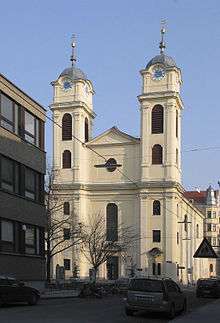Mass No. 3 (Schubert)
| Mass No. 3 | |
|---|---|
| by Franz Schubert | |
 | |
| Key | B-flat major |
| Catalogue | D 324 |
| Year | 1815 |
| Form | Missa brevis et solemnis |
| Movements | 6 |
| Vocal | SATB choir and soloists |
| Instrumental | orchestra and organ |

The Mass No. 3 in B-flat major, D 324, is a mass composed by Franz Schubert in 1815. It is scored for soprano, alto, tenor and bass soloists, SATB choir, violin I and II, viola, 2 oboes, 2 bassoons, 2 trumpets, timpani and basso continuo (cello, double bass and organ). While the length of the mass makes it a missa brevis, its large orchestral force and use of brass, woodwinds and timpani has also led to its classification as a missa solemnis.[1][2]
Background
Schubert composed this mass setting a few months after the his mass in G major, beginning on 11 November 1815.[2][3] The occasion for which it was composed is unknown; however, it is thought that the soprano soloist in the first performance was Therese Grob.[4] This suggests that it was written for the Lichtental Parish Church; Schubert may also have been attempting to create opportunities to spend time with Grob, with whom he was deeply in love.[3]
Its large orchestral component and extended orchestral interludes have been called "Haydnesque";[2] the latter's Nelson Mass has been cited as a particularly strong influence.[5] References to Mozart and Bach have also been noted.
While little is now known about the circumstances of the original performance, the mass was familiar outside Vienna. Schubert received a letter from his brother Ferdinand on 6 October 1824, saying that he had been asked to play the organ for a performance of a mass in Hainburg. The mass was by a famous composer whose identity was unknown to the invitees; upon receiving it, Ferdinand recognised his brother's work.[2][4]
Structure
The mass consists of six movements. Performances require approximately 30 minutes.
- "Kyrie" Adagio con moto, B flat major, 3/4
- Three trombones are added to the orchestration of this movement.
- "Gloria" Allegro vivace, B flat major, common time
- "Domine Deus, Agnus Dei..." Adagio, D minor, 3/4
- "Quoniam tu solus sanctus..." Allegro vivace, B flat major, common time
- "Credo" Allegro vivace, B flat major, 3/4
- "Et incarnatus est..." Adagio, F minor, common time
- "Et resurrexit..." Allegro vivace, B flat major, 3/4
- "Sanctus" Adagio maestoso, B flat major, common time
- "Benedictus" Andante con moto, F major, common time; soloists
- "Osanna" with choir.
- "Agnus Dei" Andante molto, G minor, common time
- "Dona nobis pacem..." Allegro moderato, B flat major, 6/8
References
- ↑ Shrock, Dennis (2009). Choral Repertoire. p. 383. ISBN 9780199716623.
- 1 2 3 4 Black, Leo (2003). Franz Schubert: Music and Belief. p. 38. ISBN 9781843831358.
- 1 2 Newbould, Brian (1999). Schubert: The Music and the Man. p. 36. ISBN 9780520219571.
- 1 2 Howie, Crawford (2008). "Small is beautiful: Schubert's smaller sacred works". In Reul, Barbara M.; Bodley, Lorraine Byrne. The Unknown Schubert. p. 66. ISBN 9780754661924.
- ↑ Gibbs, Christopher H. (1997). The Cambridge Companion to Schubert. Cambridge Companions to Music. p. 209. ISBN 9780521484244.
External links
- Mass No.3, D.324: Scores at the International Music Score Library Project
- Free scores of Mass No. 3 (Schubert) in the Choral Public Domain Library (ChoralWiki)